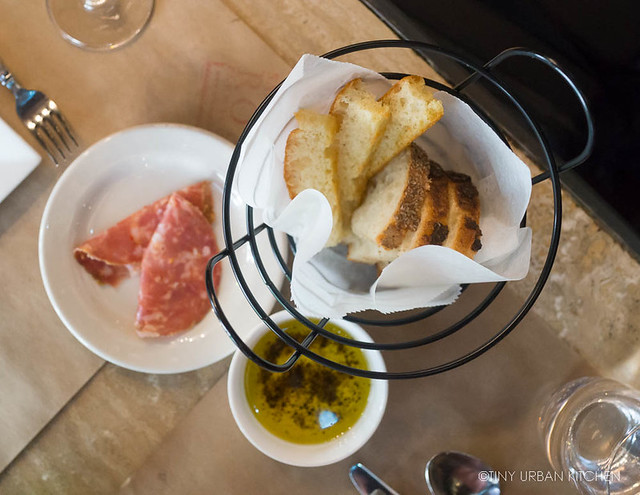
This is the third post in the series A Casual Weekend in New York. Other posts include Frank Pepe's Pizza and Salumeria Rossi Parmacotto.
It's a well known fact that Times Square itself is pretty much a culinary deadzone. As you walk between the huge M&M Store, the loud flashy billboards, and the hoards of people, you glance between your choices:
Should I eat at the Olive Garden, Planet Hollywood, or that huge McDonalds that overlooks the square?
Choices choices.
It wasn't until years later that I learned that if you just walked a few blocks away from Times Square, there were actually plenty of excellent places at which to dine. Much better choices.
On our last night in New York, we had to make a choice.
 We had enjoyed a delightful lunch at one of our favorite Italian eateries. We knew we didn't have much time before our 7PM train back to Boston. Bryan was loathed to eat train food for dinner (do they even sell food on the train?), and he really didn't want to wait until midnight to eat in Boston.
We had enjoyed a delightful lunch at one of our favorite Italian eateries. We knew we didn't have much time before our 7PM train back to Boston. Bryan was loathed to eat train food for dinner (do they even sell food on the train?), and he really didn't want to wait until midnight to eat in Boston.So we had to find something relatively close - a place that wouldn't balk if we walked in with our casual dress and suitcases. After a not-so-brief search online (hey, these things are important!), we found the highly reviewed Szechuan Gourmet right on 39th street, only 5 blocks from Penn Station.
Perfect.

Szechuan Gourmet is not really a hidden secret in New York. It has a spot on Eater's coveted 38 Essential Restaurants list. The Food Network's show "The Best Thing I Ever Ate" also featured Szechuan Gourmet's Crispy Lamb Filet on its show about Chopsticks. Frank Bruni gave this place two stars in his glowing New York Times review back in 2008.
We ordered some of our favorites Sichuan dishes, such as Braised Spicy Fish Filets with Napa Cabbage (literally "water-cooked fish" in Chinese), Ma Po Tofu, Stir Fried String Beans, and Stir Fried Shredded Potato.

Everything was quite good. The Mapo Tofu could have used a bit more Sichuan peppercorns, and the string beans were just at tad greasy. Overall, though, the flavors were decidedly authentic and full of intensity.
My favorite dish was the Stir Fried Shredded Potatoes (thanks to the recommendation from Frank Bruni in his New York Times review), which were delightfully crispy and surprisingly flavorful. They tasted more like a vegetable than a starch. It reminded me of a similar (but also different) dish I like to get in Boston.

Is it the best Sichuan food I've ever had?
Probably not, but then perhaps I'm a bit spoiled.
We have some pretty good Sichuan food here in Boston. In fact, well-known food writer Kenji Lopez-Alt from Serious Eats has even gone so far as to say "Boston's got Sichuan Restaurants that puts even the best in New York to shame, and that includes those in Flushing" (emphasis added). [source]
I haven't eaten at enough places in Boston or New York to make such a strong statement. However, I will say that this restaurant, which is pretty revered as far as New York Sichuan restaurants are concerned, is at least equal to the best places in Boston.
I'm not complaining. It's awesome that there's such a good place right in Midtown Manhattan. All in all, the food at Szechuan Gourmet is very good. The intense and authentic flavors from their ample use of Sichuan peppercorns was most certainly present. Their general command of flavors is good, and every dish was really quite enjoyable.
Best yet, it was fast, which is great when you're rushing to be on time for that train.
I'm sure I'll be back again . . . suitcase and all.
 Szechuan Gourmet
Szechuan Gourmet21 W 39th St
New York, NY
















































